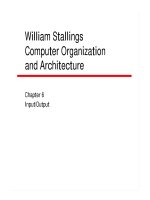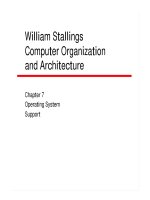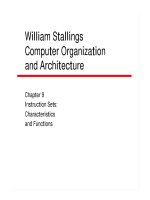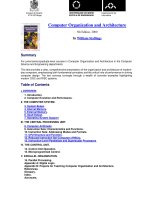Tài liệu William Stallings Computer Organization and Architecture P4 docx
Bạn đang xem bản rút gọn của tài liệu. Xem và tải ngay bản đầy đủ của tài liệu tại đây (37.65 KB, 30 trang )
William Stallings
Computer Organization
and Architecture
Chapter 9
Instruction Sets:
Characteristics
and Functions
What is an instruction set?
§ The complete collection of instructions that are understood by a
CPU
§ Machine Code
§ Binary
§ Usually represented by assembly codes
• Assembly language is a symbolic representation of machine L.
Elements of an Instruction
§ Operation code (Op code)
• specifies operation to be performed
• Represented by mnemonics (SUB, ADD)
§ Source Operand reference
• Input to the operation
• 1 or 2 (can be constant, in a reg, mem, I/O)
§ Result Operand reference
• Put the answer here (Reg, Mem, I/O)
§ Next Instruction Reference
• Tells CPU where to fetch next instruction
• On most case, next instruction to be fetched immediately
follows current instruction
Instruction Representation
§ In machine code each instruction has a unique bit pattern
§ For human consumption (well, programmers anyway) a symbolic
representation is used
• e.g. ADD, SUB, LOAD
§ Operands can also be represented in this way
• ADD A,B
Instruction Types
§ Data processing
• Arithmetic & Logic instruction
üProcess numeric data
üOperates on bits of the word as bits and not as numbers
§ Data storage (main memory)
• Register - memory
§ Data movement (I/O) (IN, OUT, Memory mapped I/O)
• I/O – Memory
• I/O – Reg.
§ Program flow control
• Test & branch
• Testing data, status of computation (zero, overflow)
• Branch to some location depending on decision
Number of Addresses (a)
§ # of address allowed in an instruction
§ Decide the categories of processor architecture
§ 3 addresses
• Operand 1, Operand 2, Result
• a = b + c;
• May be a forth - next instruction (usually implicit)
• Not common
• Needs very long words to hold everything
Number of Addresses (b)
§ 2 addresses
• One address doubles as operand and result
• a = a + b
• Reduces length of instruction
• Requires some extra work
üTemporary storage to hold some results
Number of Addresses (c)
§ 1 address
• Implicit second address
• Usually a register (accumulator)
• Common on early machines
§ Adv.
• Minimize internal state of machine
• Short inst.
§ Dis.
• One register (A) à high memory traffic
Number of Addresses (d)
§ 0 (zero) addresses
• All addresses implicit
• Uses a stack
üOperands are on top of stack
• e.g. push a
• push b
• add
• pop c
• c = a + b
Dis, stack can not be accessed randomly
-> difficult to generate efficient code
à longer program
Ad. Short instruction
example
§ D = A + B + C
(stack) ACCUMULATOR 2-ADDRESS 3-ADDRESS
HP 3000 PDP-8 INTEL 8086 VAX
===========================================
PUSH A LOAD A LOAD R1, A ADD D, A, B
PUSH B ADD B ADD R1, B ADD D, D, C
ADD ADD C ADD R1, C
PUSH C STORE D STORE D, R1
ADD
POP D
ß---------------------------- short instruction
---------------------------à compact program, longer inst.
How Many Addresses
§ More addresses
• More complex (powerful?) instructions
• More registers
üInter-register operations are quicker
• Fewer instructions per program
§ Fewer addresses
• Less complex (powerful?) instructions
• More instructions per program
• Faster fetch/execution of instructions
Design Decisions (1)
§ Operation repertoire
• How many ops?
• What can they do?
• How complex are they?
§ Data types
§ Instruction formats
• Length of op code field
• Number of addresses









